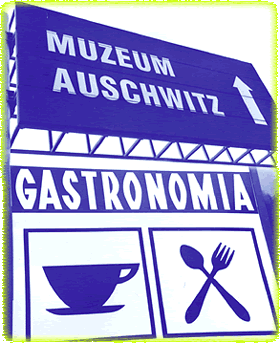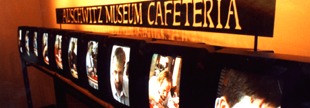
There's no business like Shoah business, to borrow the Jewish historian Yaffa Eliach's mordant one-liner.
In Selling The Holocaust, a gimlet-eyed analysis of the branding and blockbustering of the unspeakable, the historian Tim Cole argues that "at the end of the Twentieth Century, the 'Holocaust' is being consumed." (No denier he, Cole frames the term in quotes to distinguish the Holocaust as it appears in the mass-marketed conjurings of movies like Schindler's List and museums like the Holocaust Memorial Museum in Washington, D.C. from the historical horror of the assembly-line murder of millions at the hands of the Nazis.)
Evidence that the Holocaust is being trivialized, merchandised, and (through feel-good Hollywood confections and theme-parked museums), Americanized, is all around us. The revisionist happy endings of Roberto Benigni's movie Life is Beautiful and the Robin Williams vehicle Jakob the Liar domesticate the Holocaust, deodorize the memory of its poison gas and its open-pit graves. There are Holocaust-related toys, lit Lite, postcards, and games. Holocaust museums do a brisk business, and death-camp tourism is a common feature of the Grand Tour for Jews and Gentiles alike.
"Each year," writes Cole, "tourists flock [to] Auschwitz, Anne Frank House, [the Israeli Holocaust museum and memorial] Yad Vashem, the museums in Washington, D.C., Dallas, Houston." In museum gift shops, visitors can buy mementos, from pins trumpeting the trademark-ready phrase "Never Again" to postcards (to send to friends, Cole speculates, "with the message 'Wish you were here'").
To the truly cynical, the "Holocaust" -- again, the cultural icon, not the historical event -- is, in the words of essayist Phillip Lopate, "a corporation headed by Elie Wiesel, who defends his patents with articles in the Arts and Leisure section of the Sunday Times" while competing franchises like Yad Vashem and the Holocaust Memorial Museum fight for the remaining market share.
"When in Washington, D.C.," writes Cole, "we 'consume' the 'Holocaust' on offer at the United States Holocaust Memorial Museum ... and when in Krakow we 'consume' the 'Holocaust' on offer at the State Museum at Auschwitz."
At Auschwitz, a collaborative artwork by the Jewish artist Julie S. Dermansky and the Austrian filmmaker George Steinboeck, literalizes the queasy notion of consumption amid the crematoria -- in the literal as well as the capitalist sense. The installation consists of a dozen TVs playing loops of people eating in the Auschwitz museum cafeteria, as well as the couple's photos of the death camp.

Cole's grim foreboding that the "'tourist Auschwitz' threatens to trivialize the past, domesticate the past, and ultimately jettison the past altogether" comes gut-lurchingly true in Dermansky and Steinboeck's footage of tourists at the trough, shoveling in steam-table glop as if it's their last meal. A bearded young man mechanically slurps up spoonful after spoonful of soup, barely pausing for breath; a grotesquely fat man chews obscenely, wattles quivering; a beady-eyed, hawk-nosed young man glances about nervously, as if worried that someone will snatch his food off his plate.
It seems doubtful, somehow, that even the knowledge that the room where they're eating was once the camp's processing center would spoil their appetites. In the unmarked, anonymous building that now houses the cafeteria, newly arrived inmates were registered, robbed, tattooed, shaved, disinfected, and dressed in the familiar striped pajamas -- transformed from Mensch to Untermensch in what the authors of Auschwitz: 1270 to the Present unforgettably call a "humiliating baptism into the kingdom of death."
A little over half a century later, the theme-parking of the inferno is well underway. The Auschwitz imagined by the State Museum collapses the complex wartime network of 40 satellite camps and three main ones into a single, mythic netherworld of night and fog, haunted by the million dead. The guided tour of Hell begins at the infamous gate whose abandon-all-hope greeting, "Arbeit macht frei" (work will set you free), is a fixture in our collective nightmares, despite the fact that "very few of the Jews deported to Auschwitz ever saw that gate," according to the authors of Auschwitz: 1270 to the Present.
The tour's somber terminus, carefully orchestrated for maximum effect, comes when visitors arrive at the crematorium. Guides don't trouble them with the burdensome truth that the actual site of the mass murders lies two miles away, in ruins; the scene of their solemn communion is in fact a postwar reconstruction, equipped with a portentous chimney whose function is purely (if powerfully) symbolic, since it is not in any way connected to the ovens.
The State Museum, which Cole rather flippantly calls "Auschwitz-land," is "a contrived tourist attraction," he argues, a misconstruction of history that effaces the past in the name of enshrining it. This is the Faustian bargain of the State Museum, which like all museums is in the business of stage-managing historical memory. "In constructing a mythical 'Auschwitz,'" Cole asserts, "we distort the horrific reality of Auschwitz, and in its place create an 'Auschwitz' which is open to the attack of those who would deny that the Holocaust ever took place. Representing the complexities of the past in a ghoulish theme park for the present has consequences."
One of those consequences, as Cole suggests, is the evisceration of history in a made-for-TV world where the past is increasingly experienced as a whirl of free-floating images, cut loose from context and complexity. It's instructive, for example, that many take Schindler's List as a historical newsreel, not a Spielberg vision of a Holocaust with a happy ending. Tourists on "Schindler's List tours" of the Krakow ghetto where the movie was set are taken to the locations where the movie was filmed, rather than the sites where the Holocaust actually happened.
Increasingly, not only the past but much of the present is mediated by flickering screens and phone lines. Part of the psychological fallout of the virtualization of reality is the death of affect that J.G. Ballard calls "the greatest casualty of the twentieth century" -- a psychic numbness that cultural commentators from Camus to McLuhan have argued is a salient characteristic of our media-bombarded, hyperstimulated culture. It's distinguished by the disengagement from immediate experience, a cauterization of the soul evidenced by Cole's anecdote about the visitor who toured Auschwitz in a T-shirt emblazoned with the name of the heavy metal band Megadeth, or the tourists Dermansky and Steinboeck saw "going through the crematoriums, laughing, filming each other," or the grandfatherly Auschwitz visitor whom the historian Paul Levine overheard asking his companions if there'd be time for shopping after their death-camp sightseeing.
In their artists' statement, Dermansky and Steinboeck write, "Auschwitz represents the inhumanity human beings are capable of. People eating in the cafeteria reveal how insensitive mankind is to its own history. Or perhaps we missed something, and walking through the grounds at the museum really does give one an appetite, as would touring the grounds of a theme park."
Watching their videos, we wonder what sort of human can eat lunch in a death camp. Or are they human? They seem to have stepped out of a sick-funny sitcom dreamed up by George Grosz and Mel Brooks. From our vantage point on the moral high ground, they're reminiscent of the SS physician who wrote in a 1942 diary entry that after a hard day's work of sending innocent men, women, and children to the gas chamber, he sat down to a "truly festive meal" of "baked pike, as much as we wanted, real coffee, excellent beer, and sandwiches."
What sort of monster works up an appetite in a hellworld of living skeletons, where the smoke and reek of burning bodies reaches to heaven? The tourists stuffing their faces in At Auschwitz are similarly swinish, soulless -- "useless eaters," we think. That is, until we remember, with a jolt, the origin of that pungent phrase: Hitler's pet phrase for the "subhumanity" fit only for the chimneys of the Auschwitz and other living hells like it.
In a creepy, deeply disorienting turnaround, we suddenly find ourselves face to face with our inner Nazis, the side of us that reassures us that the difference between us and the unfeeling creatures chowing down in a death-camp cafeteria is that they are somehow less than human. That, ironically, is the first step down the slippery slope that ends in the abyss.
Mark Dery is a cultural critic. His collection of essays, The Pyrotechnic Insanitarium: American Culture on the Brink, was published by Grove Press. His commentaries can be heard on the nationally syndicated "Radio Nation," and he was recently appointed a guest lecturer for January 2000 in UC Irvine's Distinguished Fellow program.
